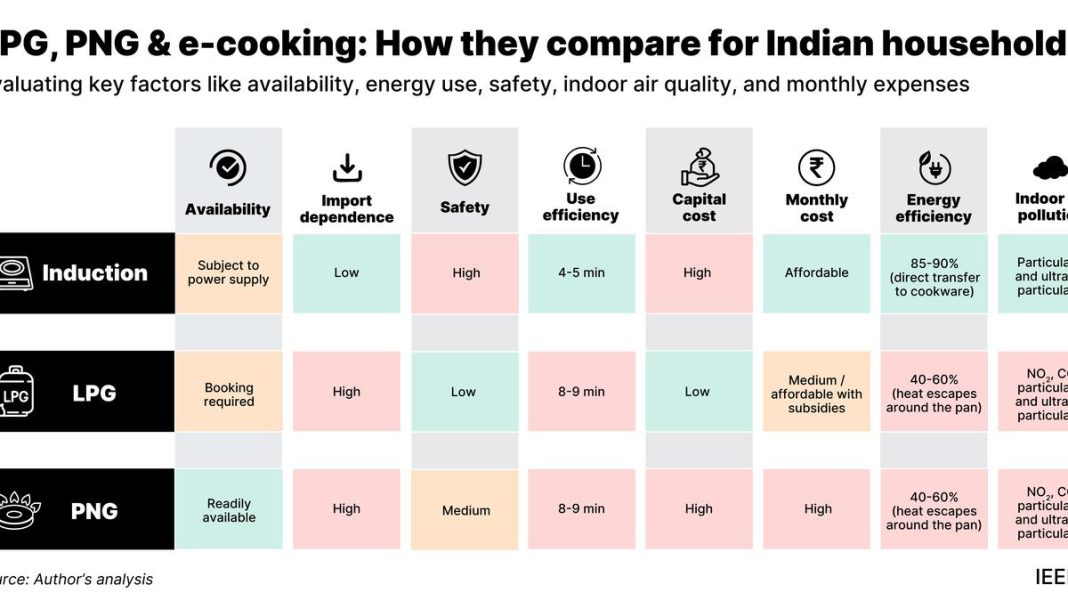Key Takeaways
- Electric cooking is 37% cheaper than non-subsidised LPG and 14% cheaper than PNG.
- High upfront costs and low awareness are major adoption barriers.
- Shifting urban households to e-cooking could free up LPG/PNG for rural areas.
- Policy support and financing options are crucial for widespread adoption.
A new IEEFA report reveals electric cooking (e-cooking) as India’s most affordable and sustainable household cooking option. It offers significant cost savings over traditional fuels, positioning it as a key solution for the country’s clean energy future.
Substantial Cost Advantages of E-Cooking
According to the Institute for Energy Economics and Financial Analysis (IEEFA), e-cooking is 37% cheaper than non-subsidised LPG and 14% cheaper than piped natural gas (PNG). This makes it particularly compelling for urban households with stable electricity access.
“Electricity-based cooking means cost savings,” said Purva Jain, IEEFA energy specialist and report author. “Based on FY2024-25 analysis, PNG can be 14% more expensive for households, while non-subsidised LPG can be 37% more expensive.”
Only heavily subsidised LPG under the Pradhan Mantri Ujjwala Yojana remains cheaper than e-cooking for beneficiaries.
Barriers to Widespread Adoption
Despite near-universal electrification, e-cooking uptake remains slow. Jain identifies high upfront costs for induction cooktops and compatible utensils, limited device options, and low consumer awareness as primary barriers.
“The initial cost can be a barrier. We need government support to reduce capital costs and build consumer confidence,” she emphasized.
National Energy Security Implications
India’s LPG and LNG import bills have surged by 50% over six years, reaching ₹2.2 lakh crore in FY2024-25 – nearly 3% of total import expenditure. This exposes the country to global price volatility and geopolitical risks.
While cleaner than traditional solid fuels, LPG and PNG remain carbon-intensive. Approximately 40% of Indian households still rely on polluting fuels like firewood and dung for cooking.
Jain suggests shifting urban households to e-cooking could free up LPG and PNG resources for rural areas where clean cooking access remains limited.
Addressing Practical Concerns
Grid Load Management
Regarding grid load concerns, the report notes India is strengthening its national grid. Policy interventions like time-of-day tariffs and energy-efficient device standards can help manage peak demand.
Cultural Adaptation
Cultural resistance to non-flame cooking presents another challenge. Jain points to real-life examples showing chapattis can be cooked easily on induction cooktops.
“For hesitant households, fuel stacking is practical. Start with boiling water or milk, cooking rice – simple steps on a single induction cooktop,” she advised.
Institutional Adoption Models
The report highlights successful institutional e-cooking demonstrations, including Anganwadis supported under the National Efficient Cooking Programme. Kerala’s Angan-Jyoti scheme integrates e-cooking with solar power and energy-efficient cooling to promote grassroots sustainability.
Alignment with Decarbonisation Goals
While not quantifying lifecycle emissions, Jain notes e-cooking aligns with India’s decarbonisation objectives. “With the increasing greening of our electricity grid, relying on e-cooking as the fuel of the future is a good strategy,” she said.
Financing and Policy Requirements
The report acknowledges the need for financing solutions like EMIs and carbon credit programs to manage higher upfront costs. Jain calls for a national roadmap with clear timelines to boost consumer and manufacturer confidence.
“The report is a small step in advocating the need for a detailed roadmap. We need to boost consumer and manufacturer confidence,” she stated.
Jain emphasizes that e-cooking represents more than an alternative – it’s a future-ready solution offering affordability, safety, and sustainability.
“It’s time we reimagine clean cooking in India. Electric cooking is the next frontier,” she concluded.




